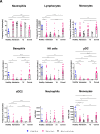Chronic Comorbidities in Middle Aged Patients Contribute to Ineffective Emergency Hematopoiesis in Covid-19 Fatal Outcomes
- PMID: 36990888
- PMCID: PMC10015105
- DOI: 10.1016/j.arcmed.2023.03.003
Chronic Comorbidities in Middle Aged Patients Contribute to Ineffective Emergency Hematopoiesis in Covid-19 Fatal Outcomes
Abstract
Background and aims: Mexico is among the countries with the highest estimated excess mortality rates due to the COVID-19 pandemic, with more than half of reported deaths occurring in adults younger than 65 years old. Although this behavior is presumably influenced by the young demographics and the high prevalence of metabolic diseases, the underlying mechanisms have not been determined.
Methods: The age-stratified case fatality rate (CFR) was estimated in a prospective cohort with 245 hospitalized COVID-19 cases, followed through time, for the period October 2020-September 2021. Cellular and inflammatory parameters were exhaustively investigated in blood samples by laboratory test, multiparametric flow cytometry and multiplex immunoassays.
Results: The CFR was 35.51%, with 55.2% of deaths recorded in middle-aged adults. On admission, hematological cell differentiation, physiological stress and inflammation parameters, showed distinctive profiles of potential prognostic value in patients under 65 at 7 days follow-up. Pre-existing metabolic conditions were identified as risk factors of poor outcomes. Chronic kidney disease (CKD), as single comorbidity or in combination with diabetes, had the highest risk for COVID-19 fatality. Of note, fatal outcomes in middle-aged patients were marked from admission by an inflammatory landscape and emergency myeloid hematopoiesis at the expense of functional lymphoid innate cells for antiviral immunosurveillance, including NK and dendritic cell subsets.
Conclusions: Comorbidities increased the development of imbalanced myeloid phenotype, rendering middle-aged individuals unable to effectively control SARS-CoV-2. A predictive signature of high-risk outcomes at day 7 of disease evolution as a tool for their early stratification in vulnerable populations is proposed.
Keywords: COVID–19; Chronic comorbidities; Chronic kidney disease; Emergency hematopoiesis; Inflammation; Middle adulthood.
Copyright © 2023. Published by Elsevier Inc.
Conflict of interest statement
Conflict of Interest The authors declare that the research was conducted in the absence of any commercial or financial relationships that could be construed as a potential conflict of interest.
Figures






References
-
- Dominguez–Ramirez L, Rodriguez–Perez F, Sosa–Jurado F, et al. The role of metabolic comorbidity in COVID–19 mortality of middle–aged adults. The case of Mexico. medRxiv. 2020:1–30. https://www.medrxiv.org/content/10.1101/2020.12.15.20244160v2.full Available from. (Accessed December 17, 2020) - DOI
Publication types
MeSH terms
LinkOut - more resources
Full Text Sources
Medical
Miscellaneous

